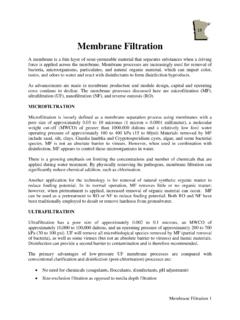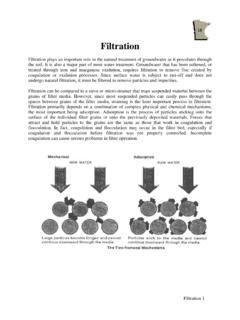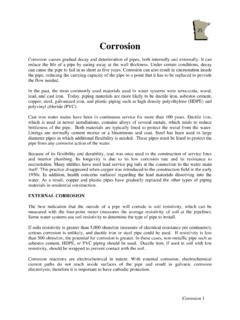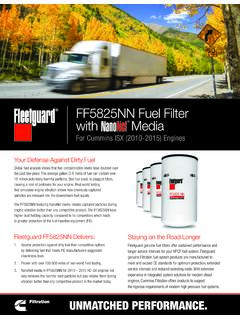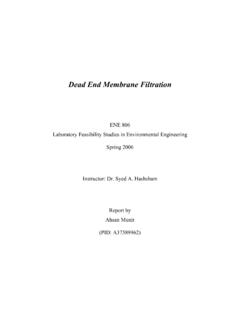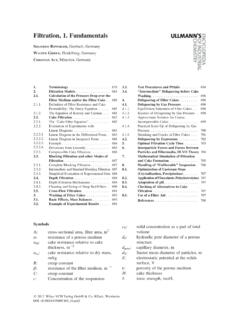Transcription of Filtration - MRWA
1 Filtration 1 Filtration Filtration plays an important role in the natural treatment of groundwater as it percolates through the soil. It is also a major part of most water treatment. Groundwater that has been softened, or treated through iron and manganese oxidation, requires Filtration to remove floc created by coagulation or oxidation processes. Since surface water is subject to run-off and does not undergo natural Filtration , it must be filtered to remove particles and impurities. Filtration can be compared to a sieve or micro-strainer that traps suspended material between the grains of filter media . However, since most suspended particles can easily pass through the spaces between grains of the filter media , straining is the least important process in Filtration . Filtration primarily depends on a combination of complex physical and chemical mechanisms, the most important being adsorption.
2 Adsorption is the process of particles sticking onto the surface of the individual filter grains or onto the previously deposited materials. Forces that attract and hold particles to the grains are the same as those that work in coagulation and flocculation. In fact, coagulation and flocculation may occur in the filter bed, especially if coagulation and flocculation before Filtration was not properly controlled. Incomplete coagulation can cause serious problems in filter operation. Filtration 2 TYPES OF FILTERS Several types of filters are used for water treatment. Early slow sand filters typically have filter rates of gpm/ft2 of surface area and require large filter areas. The top several inches of the sand has to be removed regularly--usually by hand--due to the mass of growing material schmutzdecke that collects in the filter.
3 Sand removed is usually washed and returned to the filter. These filters are still in use in some small plants, especially in the western United States as well as in many developing countries. They may also be used as a final step in wastewater treatment. Modern filters are classified as: Gravity Filters (Rapid Sand or High Rate-Dual media -Multi- media ) or Pressure Filters (Sand or Multi- media ). RAPID SAND FILTERS Rapid sand filters have filter rates 40 times those of slow sand filters. The major parts of a rapid sand filter are: Filter tank or filter box Filter sand or mixed- media Gravel support bed Underdrain system Wash water troughs Filter bed agitators Filtration 3 The filter tank is generally constructed of concrete and is most often rectangular. Filters in large plants are usually constructed next to each other in a row, allowing piping from the sedimentation basins to feed the filters from the central pipe gallery.
4 Some smaller plants are designed with filters forming a square of four filters with a central pipe gallery feeding the filters from a center wall. Filter Sand The filter sand used in rapid sand filters is manufactured specifically for the purpose of water Filtration . Most rapid sand filters contain 24-30 inches of sand, but some newer filters are deeper. The sand used is generally to mm in diameter. This is larger than the sand used in slow rate Filtration . The coarser sand in the rapid filters has larger voids that do not fill as easily. Filtration 4 Graded Gravel Gravel installed under the sand layer(s) in the filter prevents filter sand from being lost during Filtration . The under-gravel also distributes the backwash water evenly across the total filter. This under-gravel supports the filter sand and is usually graded in three to five layers, each generally 6-18 inches in thickness, depending on the type of underdrain used.
5 Underdrain The filter underdrain can be one of many types, such as: Pipe laterals False floor Leopold system Porous plates or strainer nozzles Filtration 5 Pipe Laterals A pipe lateral system uses a control manifold with several perforated laterals on each side. Piping materials include cast iron, asbestos cement, and PVC. The perforations are usually placed on the underside of the laterals to prevent them from plugging with sand. This also allows backwash to be directed against the floor, which helps keep gravel and sand beds from being directly disturbed by the high velocity water jets. False Floor The false floor design of a filter underdrain is used together with a porous plate design, or with screens that retain sand when there is no undergravel layer. This type of underdrain allows the open space under the floor to act as a collection area for the filtered water and distribution of backwash water.
6 Leopold System The Leopold system consists of a series of clay or plastic blocks that form the channels to remove the filtered water from the filter and distribute the backwash water. This type of underdrain is generally used with an undergravel layer, although some new designs allow for sand retention without gravel. Filtration 6 Washwater Troughs Washwater troughs above the filter media collect backwash water and carry it to the drain system. Proper placement of these troughs is important to ensure filter media is not carried into the troughs during the backwash and removed from the filter. Wash troughs must be installed at the same elevation, so they remove backwash evenly from the filter and an even head is maintained across the entire filter. These backwash troughs are constructed from concrete, plastic, fiberglass, or other corrosion-resistant materials.
7 Surface Wash The upper six-to-ten inches of filter media remove most of the suspended material from the water. It is important that this layer is thoroughly cleaned during the backwash cycle. Normal backwashing does not, in most cases, clean this layer completely, and agitation is needed to break up the top layers of the filter to help backwash water remove any material caught there. The surface wash system consists of a series of pipes installed in the filter to introduce high velocity water or air jet action into the upper layer of the filter. This jet action is generally supplied by rotating arms activated during backwashing. A newer design of surface wash uses compressed air to mix the upper layer and loosen particles from the sand, so backwash water can remove the particles more easily. This air wash generally is turned on before the backwash cycle. If both are used at the same time, some sand may be washed away.
8 The compressed air rate can be two-to-five cubic feet per minute per square foot (cfm/ft2) of filter surface, depending on the filter. Filtration 7 HIGH RATE FILTERS High rate filters, which operate at three-to-four times the rate of rapid sand filters, use a combination of filter media , not just sand. media combinations are generally sand and anthracite coal. Multi- media or mixed- media filters generally use sand, anthracite coal, and garnet. In rapid sand filters, fine sand grains are at the top of the sand layer with larger grains farther down the filter. As a result, the filter removes most suspended material in the first few inches of the filter. In the high rate filter, the media size decreases and the top layers consists of a coarse material with the finer material farther down, allowing the suspended material to penetrate deeper into the filter. This allows for longer filter runs at higher rates than is possible with rapid sand filters.
9 Filtration 8 Filter media used in a high rate filter depends on the raw-water quality, raw-water variations, and chemical treatment used. Pilot studies help the operator evaluate which material, or combination of materials, will give the best result. PRESSURE FILTERS Pressure filters fall into two categories: pressure sand and diatomaceous earth filters. Pressure filters are used extensively in iron and manganese removal plants. A pressure sand filter is contained under pressure in a steel tank, which may be vertical or horizontal, depending on the space available. As with gravity filters, the media is usually sand or a combination of media , and Filtration rates are similar to gravity filters. Groundwater is first aerated to oxidize the iron or manganese, and then pumped through the filter Filtration 9 to remove the suspended material.
10 Because water is under pressure, air binding will not occur in the filter. However, pressure filters have a major disadvantage in that the backwash cannot be observed; in addition, cracking of the filter bed can occur quite easily, allowing the iron and manganese particles to go straight through the filter. When using pressure filters for iron and manganese removal, the operator must regularly measure the iron and manganese concentration of the filter effluent and backwash the filter before breakthrough occurs. Because of these limitations, pressure filters must not be used to treat surface water. Diatomaceous earth filters are commonly used for the treatment of swimming pools. The process was developed by the military during World War II to remove microorganisms that cause amoebic Filtration 10 dysentery from water used in the field.
